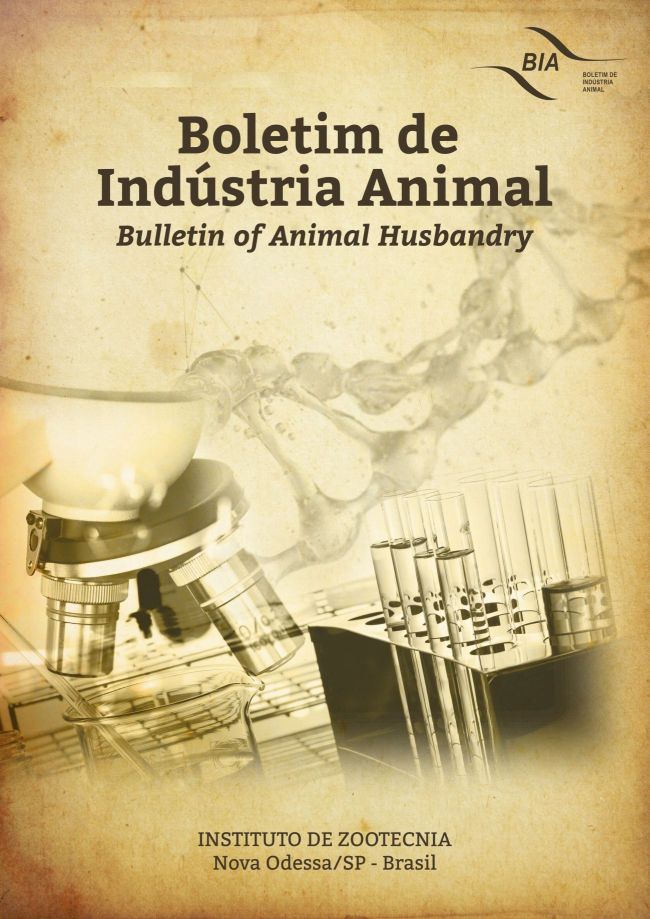Soil enzymatic activity of Brachiaria pastures managed under forage allowances
DOI:
https://doi.org/10.17523/bia.2019.v76.e1460Keywords:
arylsulfatase, cellulase, dehydrogenase, protease, soil moistureAbstract
The soil enzymatic activity reflects the microorganism€™s activity that decompose the organic matter and release nutrients to the plants. The objective was to evaluate the soil enzymatic activity in the Brachiaria pastures managed under the forage allowances of 4, 7, 10 and 13 kg MS/100 kg BW. The grazing method adopted was mob-stocking, with four grazing cycles (between December 2008 and February 2009). We also performed a sampling in June 2009 for better characterization, as the mineralization of soil organic matter occurs in the long term. The experimental design was completely randomized, with three replications and time subdivided plots. Forage allowances did not maintain a pattern of the activity of the enzyme€™s dehydrogenase, protease, arylsulfatase and cellulase. Among the cv., there was a greater (P<0.05) activity of dehydrogenase and arylsulfatase in the cv. Marandu. Activity of dehydrogenase observed was 169,90; 189,19; 185,65; 247,74; and 126,00 μg TFF/g soil, and arylsulfatase was 29,69; 31,19; 38,14; 34,22; and 38,33 μg paranitrofenol/g soil, respectively to 1, 21, 42, 63, and 183 evaluation days. The protease activity was higher (P<0.05) for cv. Marandu, with the exception of evaluation day 42, where the highest activity was for cv. Mulato (82,38 μg tirosina/g soil). For cv. Marandu, the protease activity obtained was 80,49; 108,23; 86,01; and 134,71 μg tirosina/g soil solo, respectively to 1, 21, 63, and 183 evaluation days. Marandu cultivar is the most indicate to promove better conditions for the microorganisms responsible to the enzymatic activity of dehydrogenase, arylsulfatase, and protease. It can be inferred that a longer study time is required in order to increase the specificity of the forage allowances in relation to the behavior of the enzyme activity.
Downloads
Downloads
Published
Issue
Section
License
Os autores não serão remunerados pela publicação de trabalhos, pois devem abrir mão de seus direitos autorais em favor deste periódico. Por outro lado, os autores ficam autorizados a publicar seus artigos, simultaneamente, em repositórios da instituição de sua origem, desde que citada a fonte da publicação original seja Boletim de Indústria Animal. A revista se reserva o direito de efetuar, nos originais, alterações de ordem normativa, ortográfica e gramatical, com vistas a manter o padrão culto da língua e a credibilidade do veículo. Respeitará, no entanto, o estilo de escrever dos autores. Alterações, correções ou sugestões de ordem conceitual serão encaminhadas aos autores, quando necessário. Nesses casos, os artigos, depois de adequados, deverão ser submetidos a nova apreciação. As opiniões emitidas pelos autores dos artigos são de sua exclusiva responsabilidade. Todo o conteúdo deste periódico, exceto onde está identificado, está licenciado sob a Licença Creative Commons Attribution (CC-BY-NC). A condição BY implica que os licenciados podem copiar, distribuir, exibir e executar a obra e fazer trabalhos derivados com base em que só se dão o autor ou licenciante os créditos na forma especificada por estes. A cláusula NC significa que os licenciados podem copiar, distribuir, exibir e executar a obra e fazer trabalhos derivados com base apenas para fins não comerciais.













